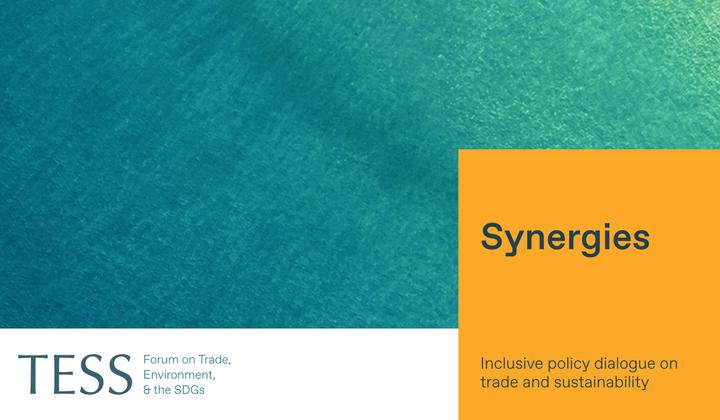As border carbon adjustments are increasingly adopted or contemplated, there are various constructive ways in which the WTO could play an important role in the context of multilateral discussions to enhance understanding of these mechanisms.
This article is part of a Synergies series on reviving multilateralism curated by TESS titled From Vision to Action on Trade and Sustainability at the WTO.
Any views and opinions expressed are those of the author(s) and do not
necessarily reflect those of TESS or any of its partner organizations or
funders.
-----
The European Union’s much-debated Carbon Border Adjustment Mechanism (CBAM), which officially entered into force in October 2023, is the first of its kind border carbon adjustment (BCA) measure being applied on cross-border trade. The CBAM primarily aims at addressing the risks of carbon leakage potentially arising from enhanced climate ambition of the bloc towards achieving climate neutrality under its Green Deal. It also intends to promote decarbonization in the EU’s trade partners by encouraging use of technologies that are more efficient in reducing greenhouse gas emissions. Such encouragement is particularly relevant for the emissions-intensive and trade-exposed sectors that are already covered under the ambit of CBAM, which (as of now) broadly include iron and steel, cement, aluminium, fertilizers, electricity, and hydrogen.
The CBAM seeks to achieve the aforesaid objectives by levelling the carbon price paid by domestically produced goods under the EU Emissions Trading System (EU ETS) and imported goods by subjecting the imports to a carbon price that is equivalent to that paid by the domestic covered installations.
CBAM – Old Wine in a New Bottle!
While the EU may be credited for coining the phrase “carbon border adjustment mechanism,” measures of this genre have traditionally been referred to as BCAs, besides other related nomenclature. The first such call for BCAs in the industrialized countries could be traced back to concerns about the lack of comparable climate commitments in developing countries and the withdrawal of the United States from the 1997 Kyoto Protocol. Years later, a similar measure was proposed in the United States in the 2009 Waxman-Markey bill (or the American Clean Energy and Security Act), in conjunction with a proposed nationwide cap and trade system. The bill, however, never became law and hence the proposed BCAs never saw the light of the day. Since then, BCAs have been periodically discussed and deliberated upon both in policy circles and academia, more so in the post-Paris Agreement world.
Border carbon adjustments have been discussed and deliberated upon both in policy circles and academic for the past 20 years, more so in the post-Paris Agreement world.
Even since its launch, the EU’s CBAM has been discussed in various World Trade Organization (WTO) fora, particularly the Committee on Trade and Environment. During the EU’s latest Trade Policy Review in 2023, CBAM has also been questioned on several grounds
The EU’s trade partners, particularly those from the Global South, have contested BCAs in general, and the EU’s CBAM in particular, on multiple grounds. These include its inadequate environmental effectiveness, unilateral nature, alleged protectionist intent, questionable trade law compatibility, and extra-territorial impacts, including on climate justice and equity.
Questionable Environmental Benefits
The main reason why questions have been raised about the environmental benefits of CBAM is perhaps the lack of empirical evidence on carbon leakage. Although several ex-ante modelling studies have periodically made projections regarding the existence of carbon leakage, their projections at best indicate moderate leakage, varying from 3–15%. In contrast to the ex-ante modelling studies, empirical studies focused on the EU ETS do not find much evidence of carbon leakage ex post.
Even findings from the modelling studies on the potential environmental benefits of CBAM are at best mixed. According to a projection by UN Trade and Development (UNCTAD), although CBAM is expected to reduce carbon leakage, its overall impact on emissions reduction globally would be rather negligible. Merely 0.1% of global emissions and 0.9% of EU emissions are expected to be curtailed. While a few other modelling studies also came out with results similar to those of the UNCTAD study, a number of other studies found, on the contrary, that CBAM, when designed carefully, can effectively reduce carbon leakage and address competitiveness concerns in the domestic market. Importantly, the EU’s own official impact assessment also revealed that CBAM would curtail EU emissions merely by an estimated 1% by 2030 and global emissions in the covered sectors by 0.4%.
Unilateral Nature and Potential Impacts on Trade Partners
The unilateral manner of imposition of CBAM with an extraterritorial fallout on trade partners has raised serious questions. The BASIC grouping (Brazil, South Africa, India, and China) have critiqued CBAM, stating that: “unilateral measures and discriminatory practices, such as carbon border taxes, that could result in market distortion and aggravate the trust deficit amongst parties, must be avoided.” India, in its submission to the WTO, has argued that such measures pose “systemic implications for international law as a whole, since any unilateral action undermines multilaterally negotiated rights and obligations of countries.” China has also opposed CBAM strongly, including in its WTO submissions. The measure has also been criticized by developing countries for undermining the multilateral climate regime under the United Nations Framework Convention on Climate Change (UNFCCC).
The CBAM has further been criticized for going against the principles of equity and common but differentiated responsibilities and respective capabilities (CBDR-RC) as enshrined in the UNFCCC. A substantial body of modelling studies (see for example here, here, and here) indicates that BCAs would shift the economic burden of emissions reduction from abating industrialized countries to non-abating developing countries thus raising concerns of equity.
Complexities Around WTO Compatibility
The issue of WTO compatibility of CBAM is a complex and contentious one owing to ambiguities in existing WTO jurisprudence on several counts.
Although the EU claims that CBAM has been designed to make it compliant with WTO rules, many trading partners have expressed concerns about its WTO compatibility. Some trading partners have also indicated that they would lodge a complaint under the WTO’s Dispute Settlement System.
The issue of WTO compatibility of CBAM is a complex and contentious one owing to ambiguities in existing WTO jurisprudence on several counts. First, it is not clear whether a domestic tax based on the carbon content of a product could be eligible for adjustment at the border. Moreover, even if a domestic carbon tax is determined to be adjustable at the border, it must additionally be ensured that the concomitant border tax adjustment abides by the national treatment requirement—a pillar of the non-discrimination principle of the WTO, the other being most favoured nation, which also has to be complied with.
Another big question that comes up in this context pertains to that of “like” products: whether under WTO jurisprudence products can be regarded as “non-like” only on the basis of their differing carbon content. There also is significant uncertainty in existing WTO jurisprudence on this question, which further adds to the ambiguities pertaining to the WTO legality of any BCA. Importantly, even if a BCA turns out to be violative of any General Agreement on Tariffs and Trade (GATT) provision, it still stands a chance of being justified under the “general exceptions” provision, as enshrined in Article XX. This article allows a WTO member to deviate from its GATT obligations for fulfilling certain legitimate policy objectives, including environmental ones (under Articles XX (b) and (g)), provided the conditions included in the Chapeau (that is the introductory part) of Article XX are met. While there may be a good case for a BCA to be “provisionally” justified on environmental grounds, the trickier part would be to satisfy the Chapeau, which requires that the measure is “not applied in a manner which would constitute a means of arbitrary or unjustifiable discrimination between countries where the same conditions prevail, or a disguised restriction on international trade.” Importantly, the purpose of the Chapeau is to prevent (ab)use of trade measures for protectionist purposes.
It is worthwhile to note that Article 3.5 of the UNFCCC virtually shadows the GATT Article XX Chapeau language in its aim of preventing any climate measure being applied for protectionist purposes. In fact, this article has formed the basis of all the BCA-related discussions under the UNFCCC negotiations as part of a forum on the impact of the implementation of response measures created by the UNFCCC parties in 2010.
There is a plethora of literature that explores whether BCAs could be compliant with WTO law and jurisprudence, and more specifically what kind of BCA designs could potentially help towards this compliance. It is widely argued in this literature that the ultimate determination of the WTO compatibility or otherwise of any BCA measure would depend on the nitty-gritty of the design and implementation of the measure.
To have a better chance of WTO-compliance, BCAs would need to have a clear environmental justification, should consider the mitigation efforts and concomitant costs incurred by other countries, and provide for fairness and due process in the design and implementation, among other considerations.
Risk of Enhanced Fragmentation in the World Order
Although the EU may be a frontrunner in the BCA race, it is unlikely to be alone adopting such a climate-related trade measure. Unilateral BCAs are already contemplated in various other jurisdictions, including the UK, Canada, United States, Australia, Japan, and Taiwan. All these initiatives are at different stages of fruition, with each having its own underlying context, objective, and design principles in view.
As more jurisdictions opt for unilateral BCAs as per their own requirements, the fallout could eventually be multiple BCAs with diverse or even contradictory rule books, running the risk of vitiating the environment for enhanced climate action.
As more jurisdictions opt for unilateral BCAs as per their own requirements, the fallout could eventually be multiple BCAs with diverse or even contradictory rule books. The brunt of this would eventually be borne by the exporters in the form of increased transaction costs in their endeavor to explore various BCA-imposing jurisdictions. Small players in the Global South with limited technical and financial resources could be the worst affected. Such a scenario could further aggravate trade frictions and geopolitical tensions as evinced by the reactions to the EU’s CBAM.
Such fragmented rule-making and their impact run the risk of vitiating the environment for enhanced climate action, which demands concerted global efforts in a cooperative, rather than fragmented manner.
Balancing Ambition and Equity – Some Food for Thought
Some moot questions that arise in this context are:
- Can BCAs be designed in ways such that they incentivize enhanced climate action, particularly deep decarbonization in the hard-to-abate sectors in the Global South? What could be the possible constituent elements of such a BCA?
- What role could the global trading system play to facilitate deep decarbonization as well as just transitions in the hard-to-abate sectors in the Global South that is also commensurate with the sustainable development imperatives of developing countries,?
Underlying these questions is the inherent tension between: (a) the global community’s efforts to control climate change and achieve net zero, ideally by mid-century; and (b) the legitimate right of developing countries to a just transition as well as sustainable development, as recognized by the multilateral trading system.
While a deeper exploration of the aforesaid research questions is beyond the scope of this commentary, the following paragraphs throw some reflections on possible ways forward.
The principle of common but differentiated responsibilities and respective capabilities offers broad guidance that ideally should be considered in the design and application of any border carbon adjustment.
First, the CBDR-RC principle offers broad guidance that ideally should be considered in the design and application of any BCA. Although the precise content of the principle remains contested, it emphasizes the need to account for the historical contribution to climate change by developing countries, as well as their varied levels of economic development and capabilities to undertake climate action. This is also in tune with the special and differential treatment provisions for developing countries and the least developed countries (LDCs) under the multilateral trade regime of the WTO.
Some commentators have argued in favour of a blanket exemption of the LDCs from the purview of the CBAM. Some others suggest that instead of a complete exemption, the LDCs should receive targeted support from the EU. According to one expert, CBAM’s compliance with international law would depend largely on “the EU’s disposition to both recognize non-European countries’ environmental policies, and the EU’s willingness to support developing nations on their efforts to curb carbon emissions”.
If a BCA is designed and implemented in compliance with the CBDR-RC principle, it would also increase the chance of the measure being compliant with WTO law, particularly under GATT Article XX (b) and (g) as well as the requirements under the Chapeau of the article.
Second, to make a BCA more effective in incentivizing decarbonization processes in trading partners, particularly those from the Global South, without compromising on the fairness and equity aspects, it is critical to allow for policy space and flexibility. This is also in concordance with the bottom-up approach of the Paris Agreement.
An illustration may help clarify the point better. While determining the carbon price differential between those paid by EU producers and imported products in the covered sectors in the context of CBAM, the EU would consider only the “explicit” carbon price paid in the exporting country, such as those under a carbon tax or cap-and-trade system. Instead, a more flexible approach could determine the “effective” carbon price by factoring in not only the “explicit” carbon price but also the carbon price equivalent of any “implicit” carbon price, say a fuel tax. This could be particularly important as some developing countries may encounter capacity constraints and other political and operational challenges to implement explicit carbon pricing, but may still be well positioned to implement other policies and regulations having implicit carbon price implications. Allowing for such flexibilities and policy space in a BCA design and implementation may facilitate enhanced climate action, thereby making the potential impact of a BCA more effective from an environmental perspective and also more equitable. Such flexibility could also be in alignment with the bottom-up approach of the Paris Agreement. One way of arriving at the reconciliation could be through framing mutual recognition agreements with trading partners with the aim of creating equivalence between the carbon price effectively paid by an imported product in its country of origin.
Third, another way of allaying the equity and distributional concerns is by way of recycling of the proceeds from BCA to affected developing and the least developed countries.
Fourth, if required, a BCA imposing country could provide technical and capacity building support particularly for MSMEs in the exporting countries from the Global South to aid them in their decarbonization efforts. For instance, measurement of carbon content itself may require technical support for small players.
Fifth, an open and transparent discussion with the exporting countries at the planning stage of a BCA, rather than unilateral imposition, may help improve the legitimacy of a BCA and minimize any potential political backlash against it.
A Constructive Role for the WTO
China has already called for a dedicated multilateral discussion at the WTO to enhance understanding of EU’s CBAM and other potential BCAs.
Indeed, the WTO could play an important role in this space in various constructive ways, for example by: (a) setting out basic principles and conditions for imposing BCAs; (b) specifying permissible design elements and applications; (c) setting out notification and cooperation procedures; and (d) by developing an institutional structure to facilitate capacity-building, oversight, implementation, and review of BCAs.
The overarching objective of the WTO should be to ensure that BCAs are not used in the guise of protectionism—a principle enshrined in the Chapeau of GATT, Article XX, as discussed.
Notwithstanding the efforts on multiple fronts at the WTO, the multilateral trade body is still confronted with insurmountable challenges, which include a dysfunctional Appellate Body that has plugged the “teeth” out of the organization. Among all WTO reform agenda items, restoration of the Appellate Body must assume foremost importance. A functional dispute settlement system may not only restore the WTO’s lost glory, but can, among other things, also act against any climate-related trade measure like a BCA being misused for protectionist purposes rather than advancing the cause of climate.
----------
Kasturi Das is Professor, Institute of Management Technology, Ghaziabad, Delhi-NCR, India; and Fulbright-Kalam Climate Fellowship for Academic and Professional Excellence (Research) Scholar and Visiting Fellow at the Yale Center for Environmental Law & Policy, Yale University, United States.
Kaushi Ranjan Bandyopadhyay is Chairperson, Centre for Business Sustainability, Indian Institute of Management, Lucknow, India.
The authors would like to thank the expert reviewers of this article for providing valuable comments on an earlier version, which have gone a long way in bringing the article in this final form.
-----
Synergies by TESS is a blog dedicated to promoting inclusive policy dialogue at the intersection of trade, environment, and sustainable development, drawing on perspectives from a range of experts from around the globe. The editor is Fabrice Lehmann.
Disclaimer
Any views and opinions expressed on Synergies are those of the author(s) and do not necessarily reflect those of TESS or any of its partner organizations or funders.
License
All of the content on Synergies is licensed under a Creative Commons Attribution-NonCommercial-ShareAlike 4.0 International (CC BY-NC-SA 4.0)
license. This means you are welcome to adapt, copy, and share it on your
platforms with attribution to the source and author(s), but not for
commercial purposes. You must also share it under the same CC BY-NC-SA
4.0 license.
If you would like to reuse any material published here or if you have any other question related to Synergies, send an email to fabrice.lehmann@graduateinstitute.ch.




